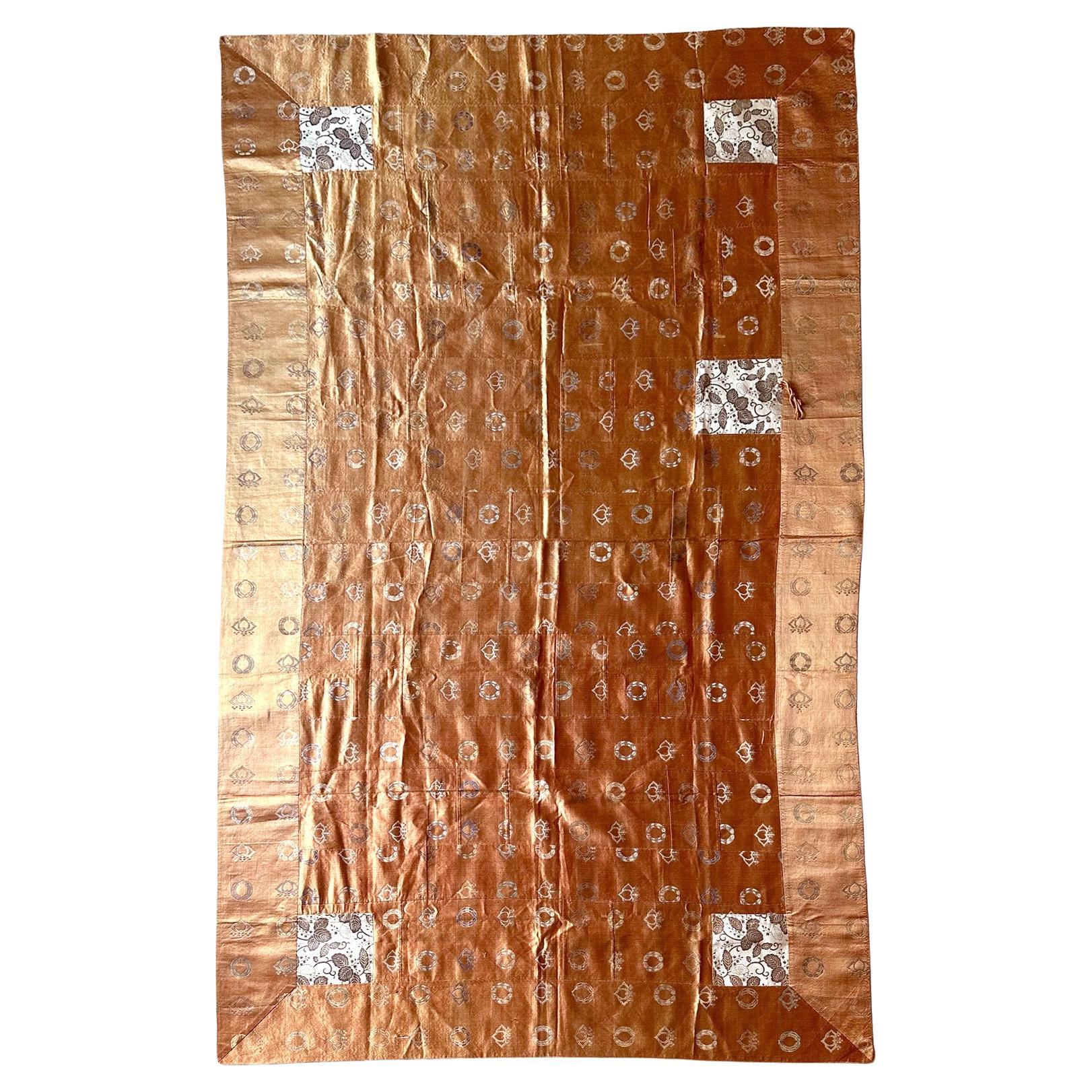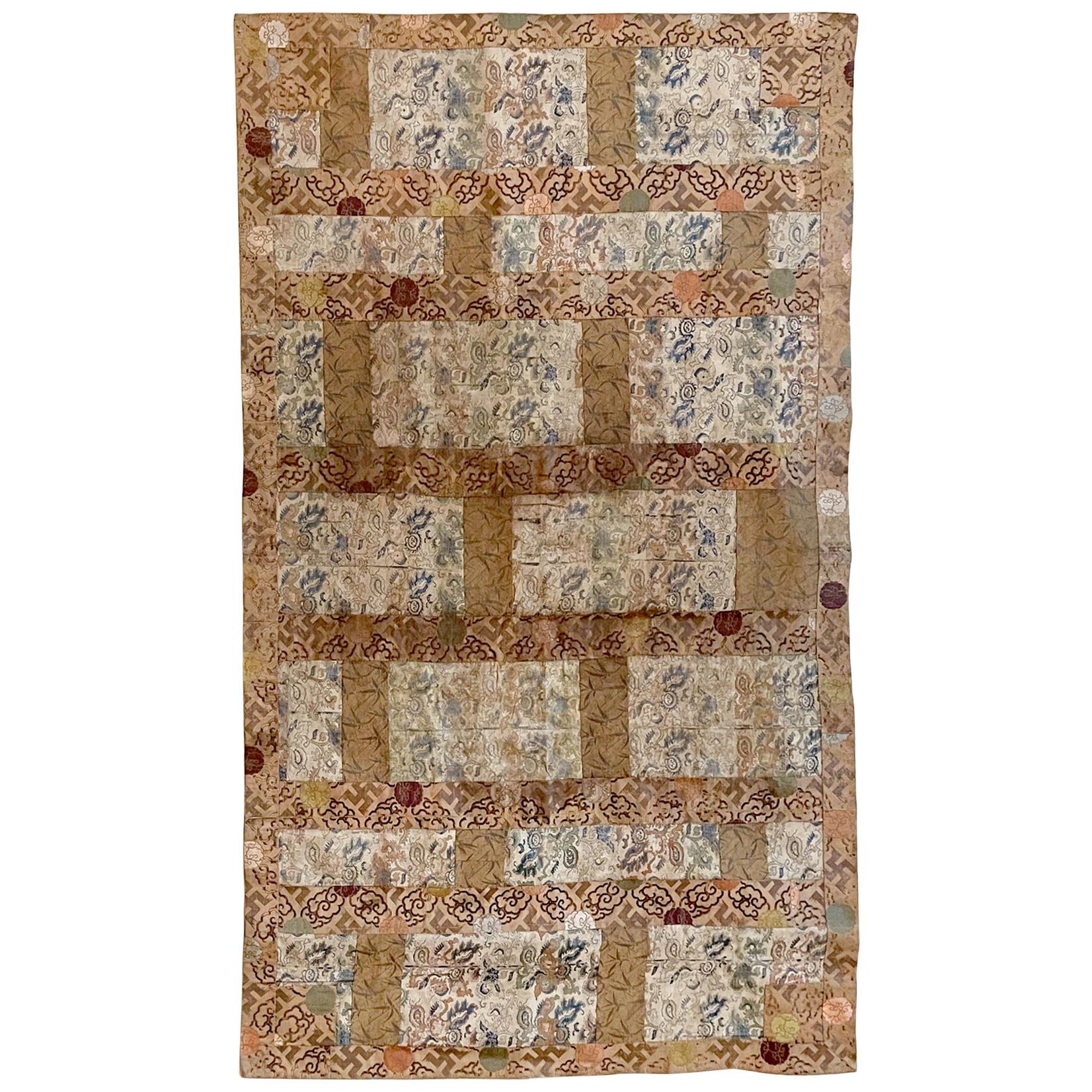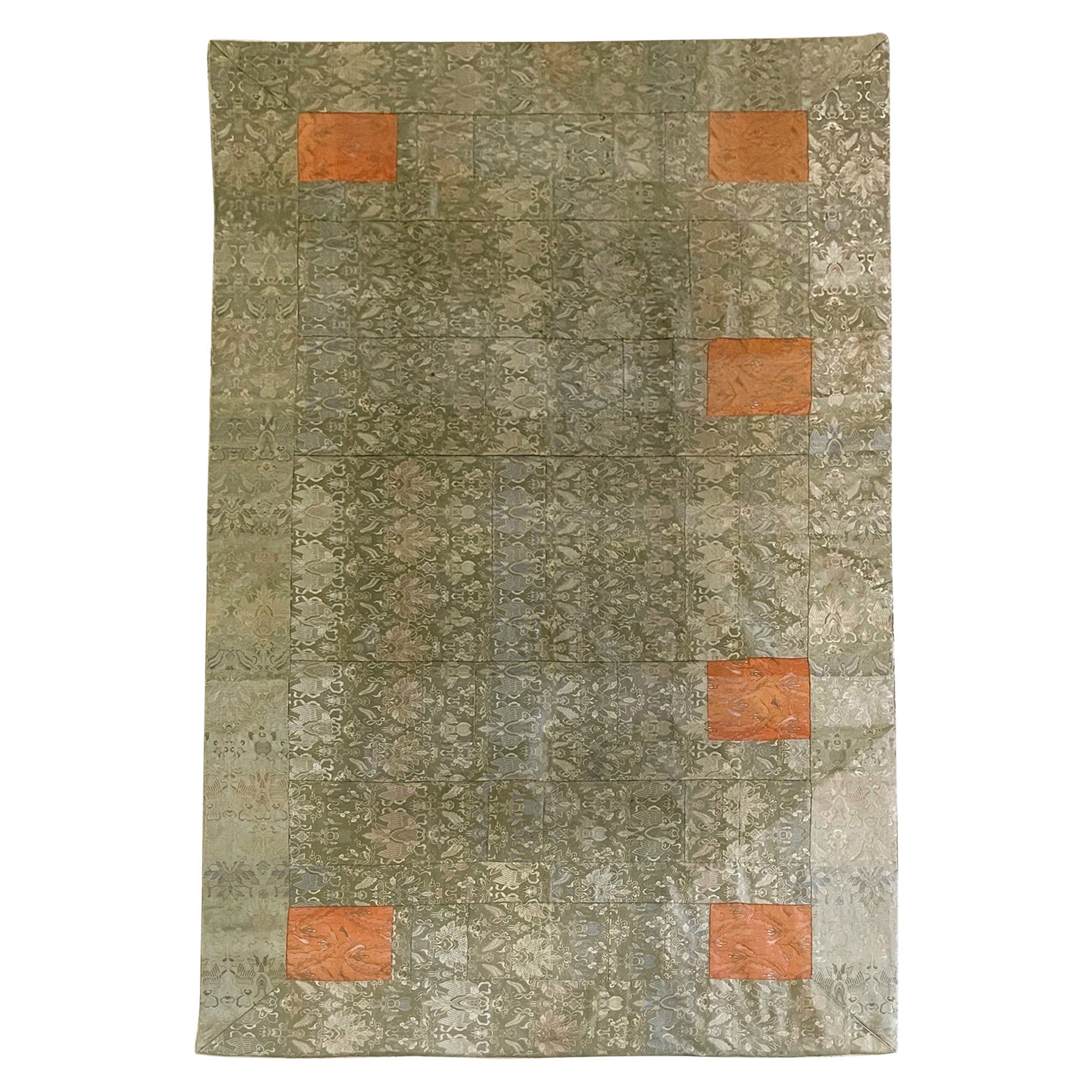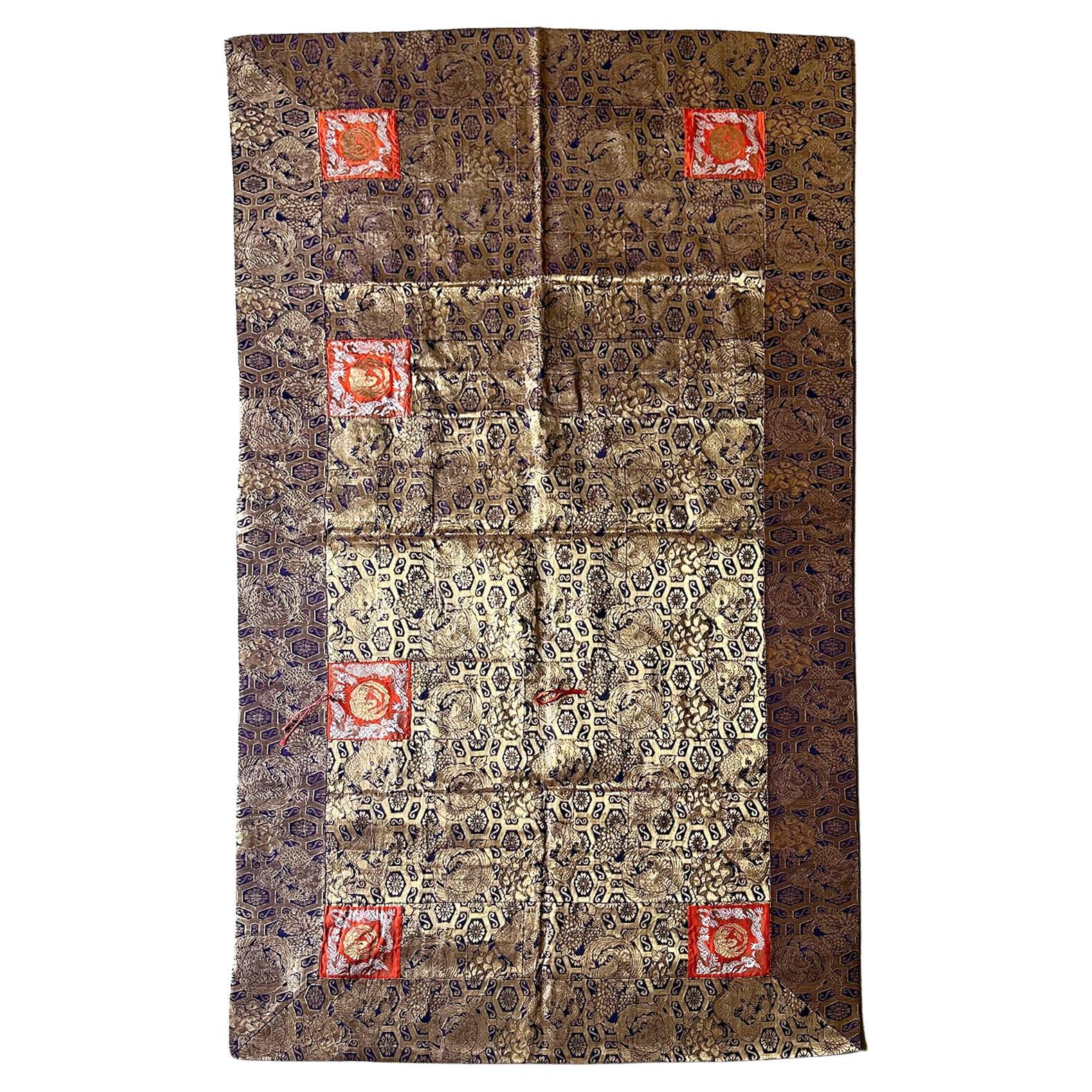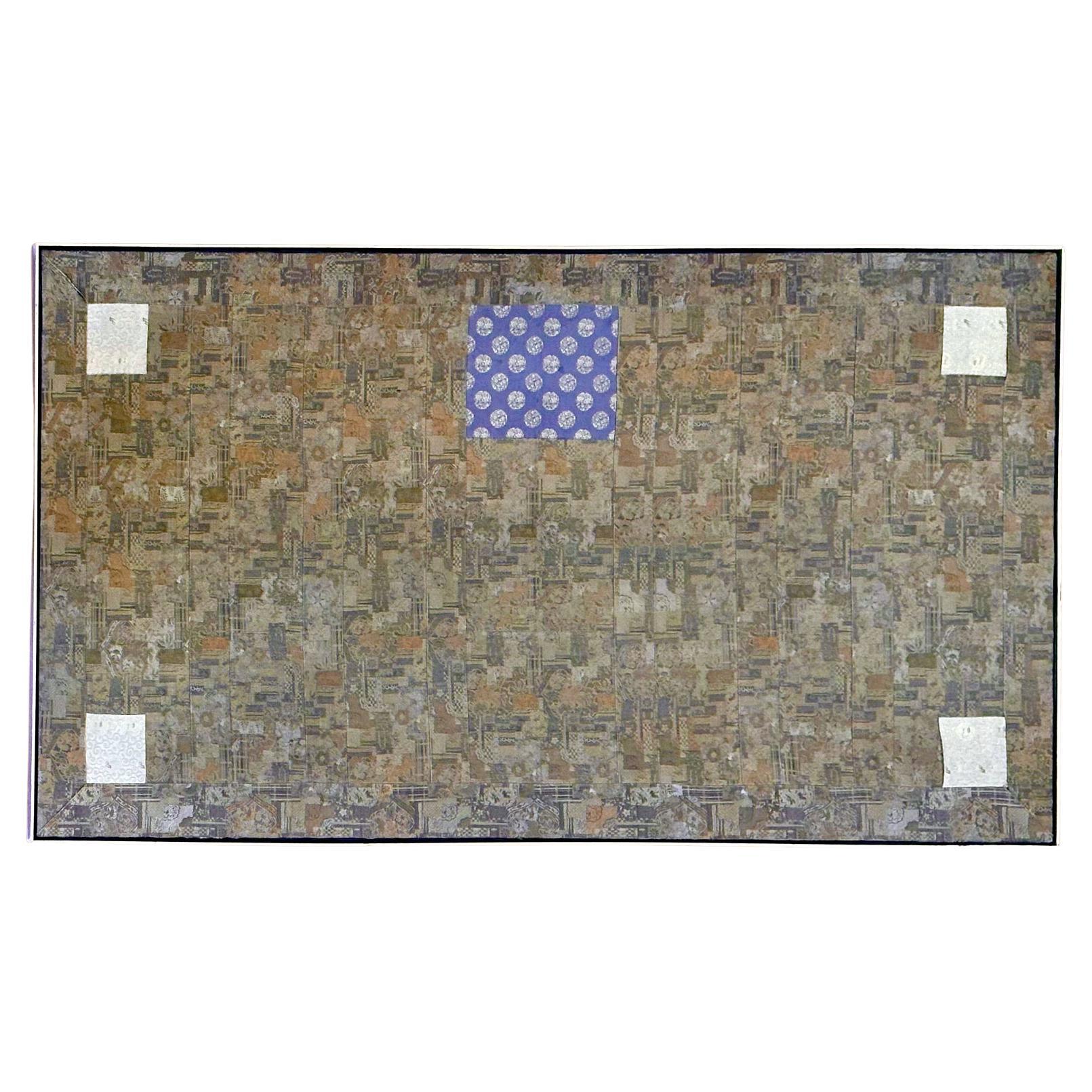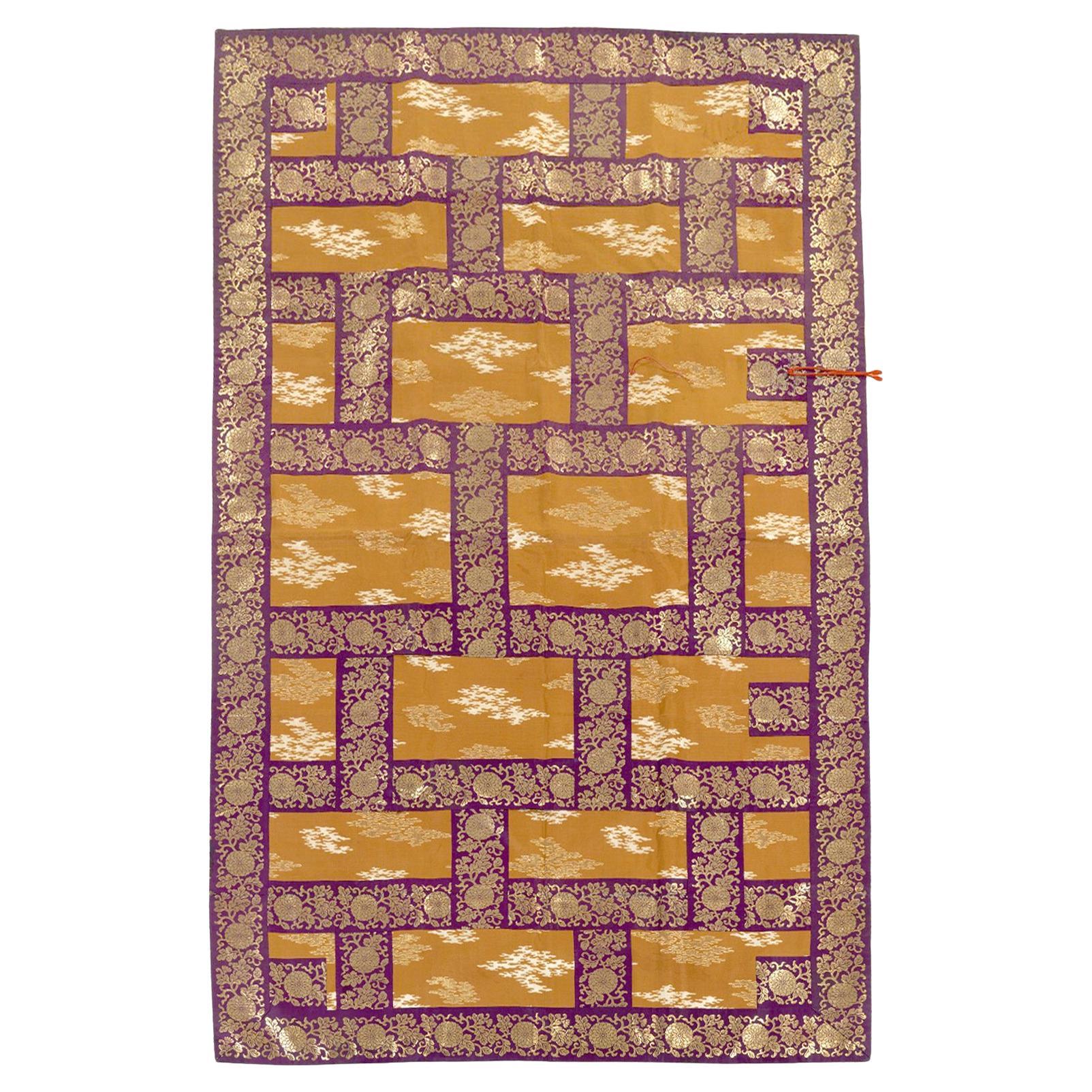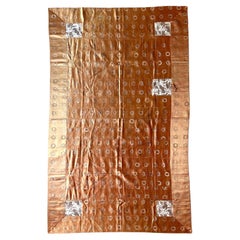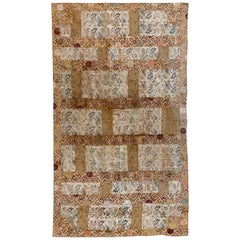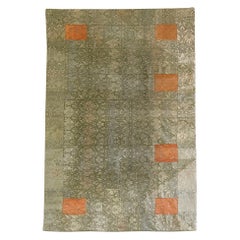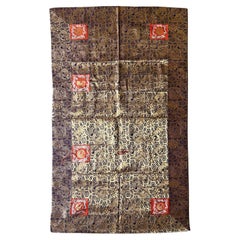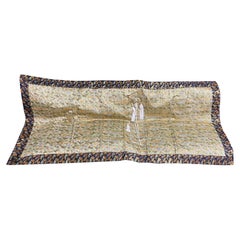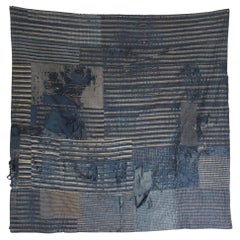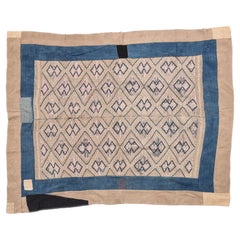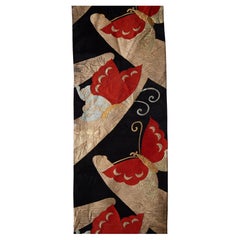Items Similar to Japanese Monastery Robe Patchwork Kesa with inscription Edo Period
Want more images or videos?
Request additional images or videos from the seller
1 of 15
Japanese Monastery Robe Patchwork Kesa with inscription Edo Period
$4,500
£3,457.18
€3,972.26
CA$6,329.81
A$7,111.25
CHF 3,715.64
MX$86,796.19
NOK 47,177.80
SEK 44,407.96
DKK 29,642.51
About the Item
A Japanese Kesa (Monk's Vestment) made from fourteen columns of patchworks of blue brocades with sumptuous woven pattern. The elaborate motifs feature repetitive pattern of flying cranes, hababishi (four petal flowers), paulownia leaves, all interlinked by Sayagata, the interlocking eternal Manji symbols in Buddhism. Six square patches of contrasting gold brocade squares were sewn to the four corners and one longitude side of the Kesa, completing the symbolism of the garment (see below). Most interest, on the saffron silk back lining of the kesa, there is a full Kanji inscription hand-written in ink. The well-preserved note reads: Wenhua fifth year (1808) January 11th date of reincarnation. By her ordained name "ShiHui" the true nun, the former wife of WeiZhong (likely a name). Enter the temple timely into the collection of daily items". What this tells us is not only the estimated age of this robe, but also it belonged to a nun instead of a monk. A piece of very intriguing historical information.
It measures 44" x 80" when fully opened. The list size is for shipping quote only when it is folded.
Kesa is derived from the Sanskrit word kasaya, meaning “dark colored,” a reference to the saffron colored robes worn by early Indian Buddhist monks. It is essentially a rectangular cloth originally sewn from patches of rags, being formless, it serves as a symbolism of the ascetic life of one's choosing. In Japan, since at least the Heian period (794–1185), the kesa has been worn by Buddhist priests as their outermost robe, draped over the left shoulder and attached under the right armpit. While it served some function of protection, it was more a signal of the wearer’s faith, and became increasingly elaborate over the centuries. During the Edo period (1600–1868), many kesa worn were patched together from exquisite silk brocade fabrics that were donated to the temples by members of the aristocracy, ruling military class, or wealthy merchants. By stitching the fabric into a patchwork robe, the monks concentrated their attention on the creation of a devotional work of art, every stitch part of an act of meditation on the teachings of the Buddha. The number of stripes (from 5 to up to 25) indicates the wearer’s rank and the occasion for which it was worn, the highest number of stripes usually only being worn by an abbot during festival ceremonies. The normal daily kesa generally have seven columns. The current fourteen column kesa is more likely a ceremonial robe for special occasion.
Additionally, four or six patches with contrasting colors were sewn onto the vestment. The four squares in the corners represent the Four Heavenly Kings (Shi Tenno). The two squares in the upper-middle section represent two compassionate bodhisattvas.
- Dimensions:Height: 44 in (111.76 cm)Width: 80 in (203.2 cm)Depth: 0.1 in (2.54 mm)
- Style:Japonisme (Of the Period)
- Materials and Techniques:
- Place of Origin:
- Period:
- Date of Manufacture:1808
- Condition:Wear consistent with age and use. Minor losses. Unframed, antique textile condition fragile but mostly intact with expected wear, note there are two small areas of losses (shown in detail picture). Silk backing shows significant fading.
- Seller Location:Atlanta, GA
- Reference Number:1stDibs: LU945030778632
About the Seller
4.9
Platinum Seller
Premium sellers with a 4.7+ rating and 24-hour response times
Established in 2006
1stDibs seller since 2010
565 sales on 1stDibs
Typical response time: <1 hour
- ShippingRetrieving quote...Shipping from: Atlanta, GA
- Return Policy
Authenticity Guarantee
In the unlikely event there’s an issue with an item’s authenticity, contact us within 1 year for a full refund. DetailsMoney-Back Guarantee
If your item is not as described, is damaged in transit, or does not arrive, contact us within 7 days for a full refund. Details24-Hour Cancellation
You have a 24-hour grace period in which to reconsider your purchase, with no questions asked.Vetted Professional Sellers
Our world-class sellers must adhere to strict standards for service and quality, maintaining the integrity of our listings.Price-Match Guarantee
If you find that a seller listed the same item for a lower price elsewhere, we’ll match it.Trusted Global Delivery
Our best-in-class carrier network provides specialized shipping options worldwide, including custom delivery.More From This Seller
View AllAntique Japanese Embroidered Silk Kesa Monk's Robe Edo Period
Located in Atlanta, GA
A Japanese Kesa (Monk's Vestment) made from thirteen columns of patchworks of fine shimmering silk fabric of a salmon orange color, the shade of which changed subtly from different a...
Category
Antique 19th Century Japanese Edo Textiles
Materials
Brocade, Silk
Antique Brocade Kesa Monk's Patched Robe Edo Period
Located in Atlanta, GA
Kesa, known as "Jiasha" in Chinese and "Kasaya" in Sanskrit, is an out layer garment worn by the ordained Buddhist monks. Bearing a basic rectangular form, it developed originally in...
Category
Antique Late 18th Century Japanese Edo Textiles
Materials
Textile, Brocade
Antique Japanese Brocade Monk's Robe Kesa Meiji Period
Located in Atlanta, GA
A Japanese Kesa (Monk's Vestment) made from thirteen columns of patchworks of shimmering woven brocades. The elaborate motifs feature repetitive elaborat...
Category
Antique Late 19th Century Japanese Meiji Textiles
Materials
Brocade, Silk
Magnificent Antique Japanese Woven Brocade Kesa Monk's Robe Meiji Period
Located in Atlanta, GA
A stunning Japanese Kesa (Monk's Vestment) made from thirteen columns of patchworks of shimmering woven brocades with luxuriant golden threads. Dated to late 19th century of Meiji Period, the elaborate woven motifs on this kesa feature repetitive roundels dragon and phoenix intermixed with peonies and chrysanthemum blossoms. Two shades of contrasting gold threads were used on a striking purplish-blue background, with a dark metallic thread for the outer border and a brighter thread for the main body. The brilliantly woven fabric was possibly recycled from Noh costumes...
Category
Antique Late 19th Century Japanese Meiji Textiles
Materials
Brocade, Silk
Antique Framed Japanese Silk Kesa Monk's Robe Edo Period
Located in Atlanta, GA
A Japanese Kesa (Monk's Vestment) made from thirteen columns of patchworks of brocades set within a border of the same material. The brocade was woven from a subtle color palette of ...
Category
Antique 19th Century Japanese Edo Textiles
Materials
Brocade, Silk
Antique Silk Kesa Monk's Patched Robe Meiji Period
Located in Atlanta, GA
Kesa, known as "Jiasha" in Chinese and "Kasaya" in Sanskrit, is an out-layer garment worn by the ordained Buddhist monks. Bearing a basic rectangular form, it developed originally in...
Category
Antique 19th Century Japanese Meiji Textiles
Materials
Textile, Brocade
You May Also Like
Japanese Buddhist Monk Priest 7 Column Silk Brocade Kesa Ceremonial Temple Robe
Located in Studio City, CA
A wonderful, beautifully ornamented and somewhat rare fully intact Japanese Buddhist monk/ priest's Kesa ceremonial silk robe featuring various colorful birds in flight.
Kesa (which came from the Chinese word "kasaya") robes have been handmade/handstitched by monks/priests as an act of devotion as ceremonial robes for centuries in various Asian cultures (Japanese, Chinese, Korean, Vietnamese, Indian, etc.). The kesa is a rectangular garment designed to be worn over the left shoulder (see example image). The robes are made (often in a patchwork column pattern ranging from five, seven, nine or more pannels) specifically for fully ordained Buddhist monks, priests and nuns and are made from donations of exquisite textiles from wealthy patrons of Japanese Buddhist temples. The robes were used in daily ceremonies, temple gatherings, and private meditation.
Antique Kesa robes...
Category
Mid-20th Century Japanese Showa Textiles
Materials
Textile, Brocade, Silk
Japanese Antique "BORO" 1800s-1860s / Rag Tapestry Patchwork Textile Wabisabi
Located in Chōsei District Nagara, JP
This is an old Japanese BORO. It was made in the late Edo period (1800s-1860s) and is an extremely valuable piece that has been carefully passed down to the present day.
BORO" is a ...
Category
Antique Mid-19th Century Japanese Edo Tapestries
Materials
Fabric
Ancient Rare GUAN-XI Embroidered Panel
Located in Alessandria, Piemonte
Ancient rare GUAN-XI embroidered panel in cotton and silk, from Southwest China.
it just needsto be mounted on a simple frame: I can do it on request, but the transport would cost mo...
Category
Antique Late 19th Century Chinese Other Pillows and Throws
Materials
Cotton, Silk
Vintage Japanese Obi Textile, Mid 20th C
Located in Istanbul, TR
An obi in very good condition that can be utilized as a table runner, wall hanging.
Category
Mid-20th Century Japanese Pillows and Throws
Materials
Silk
Saki-Ori Farmers Coat, Northern Japan, Meiji Period
Located in Point Richmond, CA
Saki-ori farmers coat, Northern Japan, Meiji period
A very heavy and substantial saki-ori coat, made of cotton with an indigo kasuri lapel. Several patches of hand sewn stitching ...
Category
20th Century Japanese Meiji Textiles
Materials
Cotton
Rare 19th-Century Brocade Silk Robe for Noh Theatre Performance, Japan
Located in Fukuoka, JP
A rare and historically significant brocade silk robe from 19th-century Japan, originally created for use in Noh theatre, one of the country’s oldest and most revered performing arts...
Category
Antique 19th Century Japanese Edo Textiles
Materials
Silk
